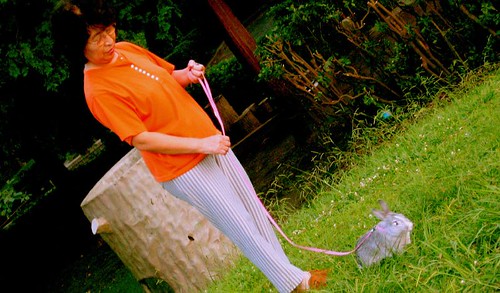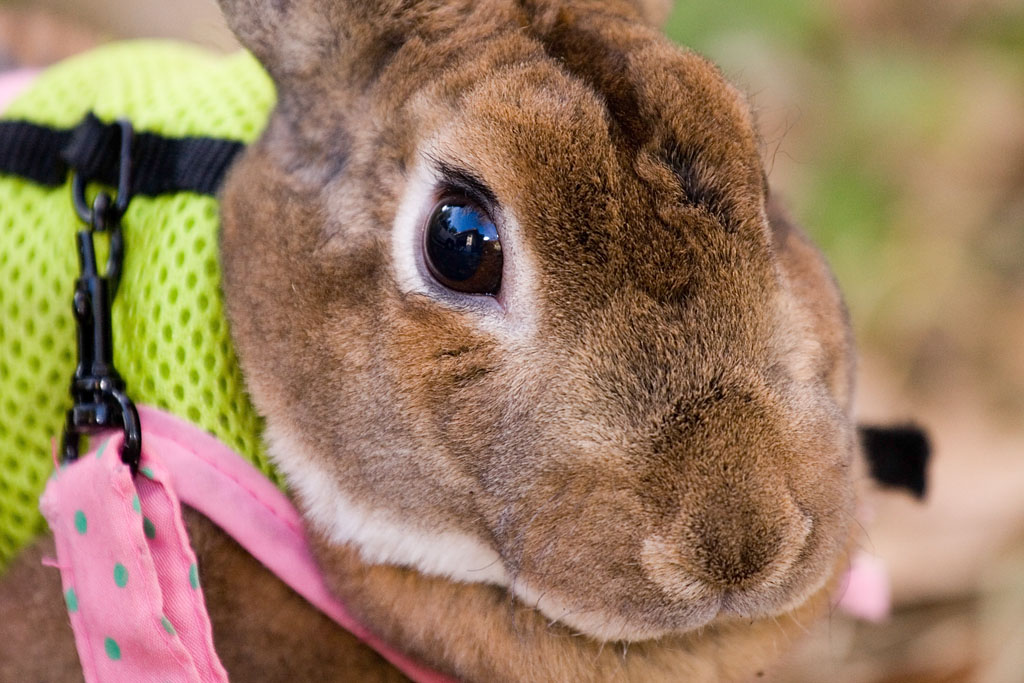Most dogs are happy to walk on a leash. Some cats enjoy it, too. But a rabbit? Actually, with the right rabbit harness and a little bit of training, many rabbits can go for walkies, too. But it’s important to keep your rabbit’s safety and comfort first in your mind.
Rabbits on a Leash: What You Need To Know

Harnesses and leashes look the same in the shop. But a harness for a dog is different from a specially designed rabbit harness. The fit is different, and the way you use the harness is different for different pets.
The purpose of a dog harness is to control your dog and lead it where you want it to go. But a rabbit harness is about safety. Instead of using it to guide your rabbit, the purpose is to allow your rabbit to safely explore the outside world without running away.
While a dog might think it’s fun to put on a harness, many rabbits need time and training to become accustomed to the idea. And rabbit owners need to learn how to interact with a leashed rabbit–because it’s a lot different from walking a dog.
Don’t expect your rabbit to hop along at your side while you lead the way. That’s not how it works. A bunny walk means you following along while your rabbit explores, always keeping an eye out for hazards and danger, and ready to scoop your bunny to safety if needed.
Is it Safe to Put a Harness on a Rabbit?

Yes, provided that you use a harness made to fit a rabbit’s body, and that you use it correctly.
Never use a neck collar or any sort of harness that tightens around your rabbit’s neck or back. A rabbit’s neck and spine are delicate, and their movements are fast, powerful, and unpredictable. With the wrong walking equipment, this is a recipe for disaster.
Because rabbits are prey animals, their first response to many new stimuli is fear. This will almost certainly be true when you introduce them to a leash and harness. If you try to jam your bunny into a harness without letting them get used to the idea, you could frighten them so that they never want to try it again. Worse, they could injure themselves, or you, trying to get away.
Leash training, like any sort of rabbit behavioural training, requires time, treats, patience, and the gentlest of gentle touches.
What Kind of Harness is Best for a Rabbit?

When it comes to choosing the best rabbit harness, two words should be at the forefront of your mind: safety and comfort. Ultimately these come down to the design of the harness and the materials from which it’s made.
Different Categories of Rabbit Harness
The best rabbit harness is a soft harness with an “H” shaped design. That is, when you lay it out flat, it looks like the letter “H.” Harnesses should have quick-release buckles that attach around the neck and under the chest. Some designs may also have a velcro closure.
The leash should not attach at the neck. Rather, it should hook to a ring along the back. Never choose a neck collar or harnesses that tighten around the neck or back.
Adjustable harnesses provide maximum comfort. Adjustable harnesses can also accommodate a growing rabbit’s changing size. Harnesses come in different sizes. If you have a small bun, make sure to choose a harness for small rabbits.
Materials
The best rabbit harness is a soft harness made from durable materials. Neoprene is a popular material, as it’s soft and comfy, but can provide a secure fit. Again, an adjustable harness will be the most comfortable and will allow you to find the most precise fit.
At Home and Roost, we’ve selected these harnesses for our customers which we believe meet all the essential criteria at a reasonable price and in a range of fun colours too!

Can You Leash Train a Rabbit?

The answer is short: yes. But the leash training process may be quite a lengthy one. How long does it take to harness train a rabbit? That depends on your method, and on your bunny’s individual personality.
Bunny owners should keep in mind that older rabbits may take a bit longer to train. And some rabbits have a longer attention span than others. Some rabbits may never take to leash training at all.
As with any type of training, leash training works best if you have a close relationship with your rabbit. If you haven’t built that human to rabbit bond yet, try spending time with your rabbit first to build that trust.
Accustom Your Bun to the Harness

The first step is to introduce your rabbit to its harness. Don’t start out by trying to make your rabbit wear the harness. It very likely won’t work.
Instead, pick a time when your bunny is feeling calm, and lay the harness nearby on the ground, perhaps near your rabbit’s toys. Let your rabbit sniff it, chew on it, play with it, and so forth.
When your bun is comfortable with the harness’s presence on site, try laying it across your rabbit’s body. Speak in a calm, soothing voice, to show your pet that there’s nothing to be afraid of. Many rabbits will require several sessions before they’re comfortable enough to progress to wearing this alien object.
Once your furry friend is happily ignoring the harness laying across them, you can try to gently slip the harness over their head and shoulders. Do not buckle the buckles yet! Instead, assess your rabbit’s reaction. Are they calmly wearing the harness, or does it bother them? If your bunny panics, it’s time to remove the harness and let them calm down. You can try again later.
Once your bunny is happily to wear the unbuckled harness, you can try buckling it.
Teach the Leash
Your rabbit will need to get used to the leash, just as they came to accept the harness. Once your bunny is comfortable wearing the harness and playing with the leash, try clipping the leash to the harness.
Again, assess your rabbit’s reaction. If your rabbit is upset by the leash, it could be a sign that it’s time to slow down.
Trial Runs
Once your bunny is happy to wear the harness and leash, try out the leash indoors. This is a safe, controlled way to judge how well your rabbit will accept a walk at the end of a lead.
Remember: the point isn’t for your rabbit to walk where you lead them. Rather, your job is to keep your rabbit safe while it explores.
Are Some Rabbit Breeds Better Suited to Leash Training?
Not necessarily. Personality is more important. For fearful rabbits, wearing a harness may feel like being caught in a net, and they may never take to the leash. More adventurous rabbits, however, may enjoy the leash and the freedom to explore life “on the outside.”
When in doubt, ask your vet for advice.
Can You Take Rabbits on Walks?

Yes. But again, rabbits are different from dogs, especially on the leash. When walking with your rabbit, your job is to make sure your rabbit is protected from predators, other animals, and other types of danger.
As you know, rabbits can find all sorts of mischief. It’s your job to prevent that.
Keep an eye on your rabbit near bushes, trees, and anywhere else where they may wander and become stuck. Rabbits are curious creatures, and you should never doubt their ability to jump into unforeseen trouble.
Other pets can also pose a threat, especially to small rabbits. If you see another pet, even a pet on a leash, be prepared to pick up your rabbit and go. The other animal may not notice your rabbit, but your rabbit may notice them and panic.
Also, you never know how another pet may react to your pet. Even the most trustworthy pet may react unpredictably to an animal it encounters in a different environment.
Never try to lead your rabbit. Don’t pull on the leash or expect your rabbit to sit, stay, or keep up with your pace. Instead, think of yourself as your rabbit’s guardian, protecting them while they go about their rabbit business.
Let the Adventures Begin!

Once your bunny has become comfortable on the leash, and you’ve learned how to keep them safe, there’s no end to the places you can go!
Does your rabbit enjoy the leash? How long did leash training take for you? We’d love to hear about your process!
















